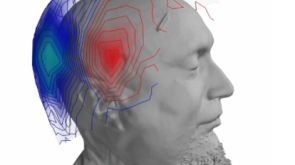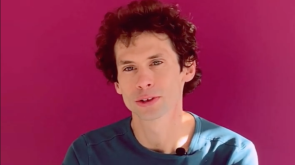
Human Auditory Ecology, a new interdisciplinary field
Over the past century, research in the field of hearing sciences has provided a wealth of knowledge about how the human auditory system processes speech and enables human beings to communicate with each other. On the other hand, knowledge remains extremely fragmentary as to how this sensory system processes “natural soundscapes”, i.e. the complex arrangements of biological and geophysical sounds shaped by the propagation of sound in non-anthropogenic habitats, and assesses ecological processes at work in these habitats.
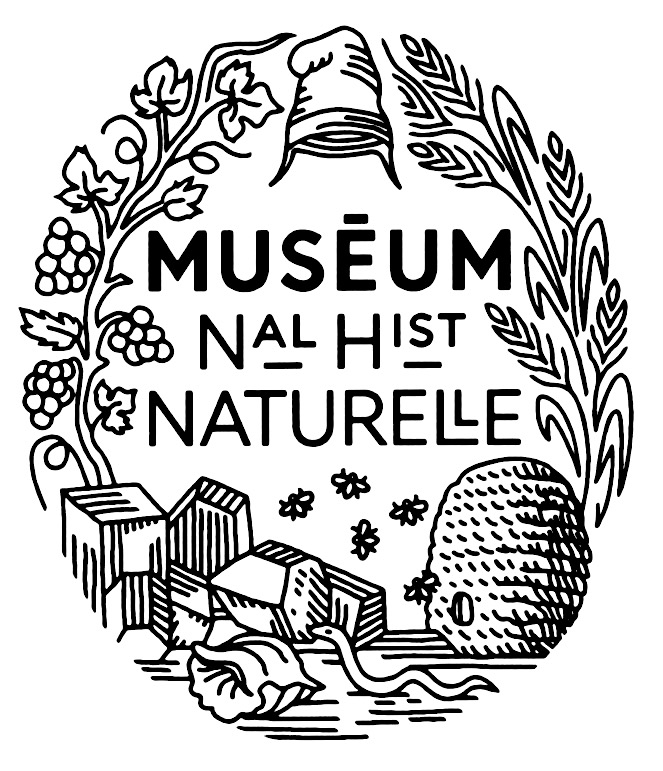 The aim of these interdisciplinary colloquia, organized as part of a partnership between the Muséum national d'Histoire naturelle and the Ecole normale supérieure (Université PSL), is to promote the scientific study of the human auditory system's ability to perceive ecological processes at work in natural habitats, by confronting hearing sciences (psychoacoustics, auditory neuroscience, bioacoustics, audiology) with the tools, data, concepts and theories of soundscape ecology and eco-acoustics. The aim of the symposium is also to encourage specialists in human and non-human hearing to consider recent work in human geography and geosciences, and to examine the implications of this work for experimental and clinical audiology and, more generally, for human health and understanding environmental change in our societies.
The aim of these interdisciplinary colloquia, organized as part of a partnership between the Muséum national d'Histoire naturelle and the Ecole normale supérieure (Université PSL), is to promote the scientific study of the human auditory system's ability to perceive ecological processes at work in natural habitats, by confronting hearing sciences (psychoacoustics, auditory neuroscience, bioacoustics, audiology) with the tools, data, concepts and theories of soundscape ecology and eco-acoustics. The aim of the symposium is also to encourage specialists in human and non-human hearing to consider recent work in human geography and geosciences, and to examine the implications of this work for experimental and clinical audiology and, more generally, for human health and understanding environmental change in our societies.
Relying on large-scale acoustic databases with high ecological validity, these new programs are designed to study the extent to which the probably ancestral monitoring functions of the human auditory system are adapted to the specific information conveyed by natural soundscapes, whether they function throughout life, or whether they emerge through individual learning or cultural transmission. Over and above the fundamental knowledge of human hearing that they will be able to provide, these new programs should enable a better understanding of how hearing and hearing-impaired people listen to and benefit from green and blue spaces, and whether rehabilitation devices (hearing aids and hearing aids) can be used to improve hearing quality.
In an effort to share these reflections with as many people as possible, the outcome of the HAE workshops are presented and updated on the ‘Human Auditory Ecology’ Wikipedia page (English).
Discussions on March 31 2025 at MNHN and April 1st 2025 at ENS should address the following questions: Can we hear "ecological processes" underlying natural habitats and ecosystems (i.e., the processes responsible for the dynamics and functions of ecological systems at multiple spatial and temporal scales) ? If so, how do we hear such ecological processes ?
The 2025 workshop will follow the same organization as in HAE 2024, with a specific emphasis on biodiversity and naturalness/wilderness perception, causal perception, hydrological processes and water perception, and effects of hearing loss and hearing aids.

HAE 2025 – Laying the foundations of the field (II)
An initial workshop to lay the foundations for the new field of Human Auditory Ecology (HAE 2024) was co-organised by ENS-PSL and MNHN in March 2024 at the exceptional Biosphere 2 research station in Tucson, Arizona, in close partnership with IRL iGlobes CNRS, ENS-PSL and the University of Arizona.
The general aim of this second workshop that will take place at Museum national d'Histoire naturelle (MNHN) and Ecole normale supérieure (ENS) in Paris on March 31st 2025 and April 1st 2025 is to refine the foundations of Human Auditory Ecology by combining work carried out in soundscape Ecology and eco-acoustics and hearing sciences, and increasing mutual awareness between each of the two scientific communities.
Discussions on March 31 2025 at MNHN and April 1st 2025 at ENS should address the following questions: Can we hear "ecological processes" underlying natural habitats and ecosystems (i.e., the processes responsible for the dynamics and functions of ecological systems at multiple spatial and temporal scales) ? If so, how do we hear such ecological processes ?
The workshop will follow the same organization as in HAE 2024, with a specific emphasis on biodiversity and naturalness/wilderness perception, causal perception, hydrological processes and water perception, and effects of hearing loss and hearing aids.
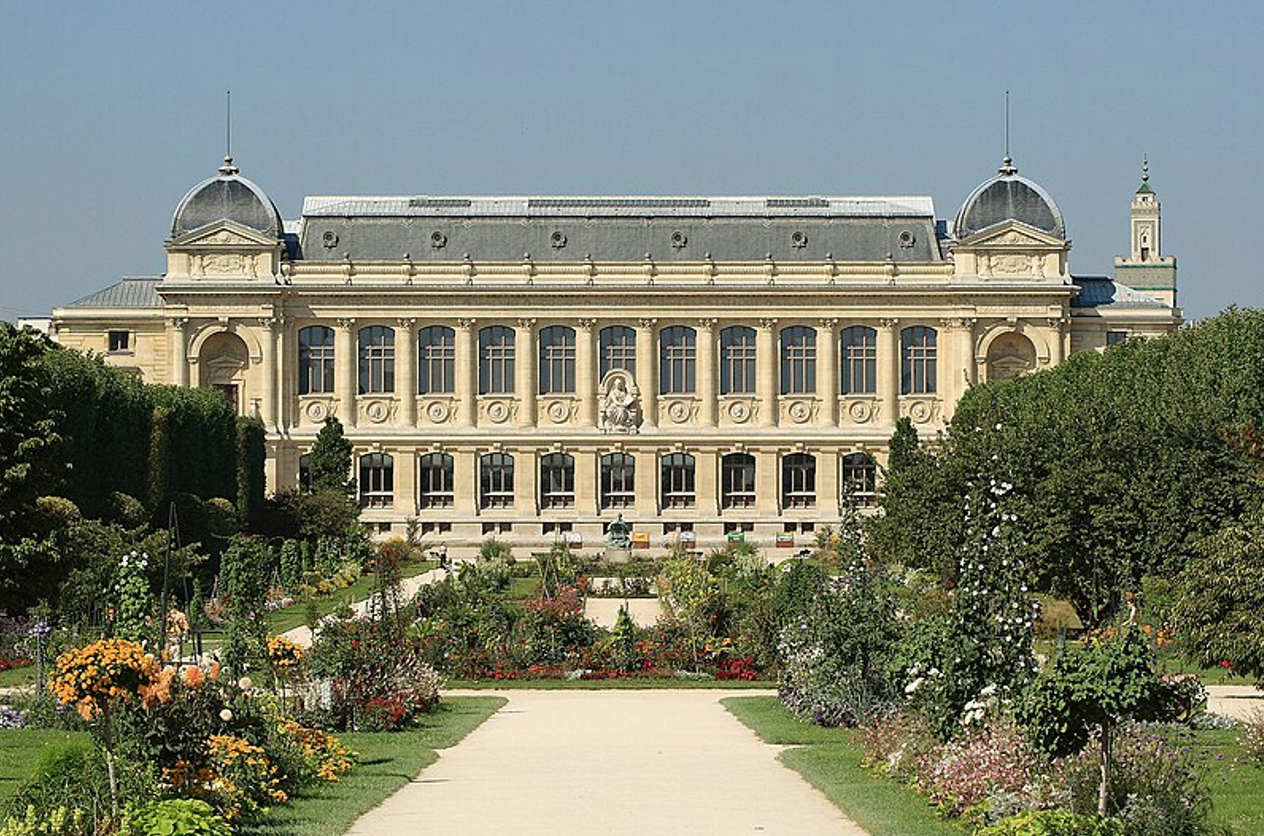
The workshop will be divided into six working sessions:
Session 1 – Acoustic and auditory features of natural soundscapes
Session 2 – Mechanisms and plasticity of natural-sound perception
Session 3 – Aquatic soundscapes : from sound to percept
Session 4 – Neural correlates of natural-sound and soundscape perception
Session 5 – Emotional responses to natural-sounds and soundscapes
Session 6 – Effects of hearing loss and hearing aids on natural-sound and soundscape perception
General discussion (all participants)
Organizing committee : Jérôme Sueur (MNHN, France) and Christian Lorenzi (ENS-PSL)
Registration is mandatory but free (number of seats is limited). To register, please follow the link below.
PROGRAM
Monday 31 March, Muséum National d'Histoire Naturelle,Amphithéatre de la Grande galerie de l'évolution, 36 rue Geoffroy Saint Hilaire, 75005 Paris (Download the program)
Registration mandatory (Only for March 31st)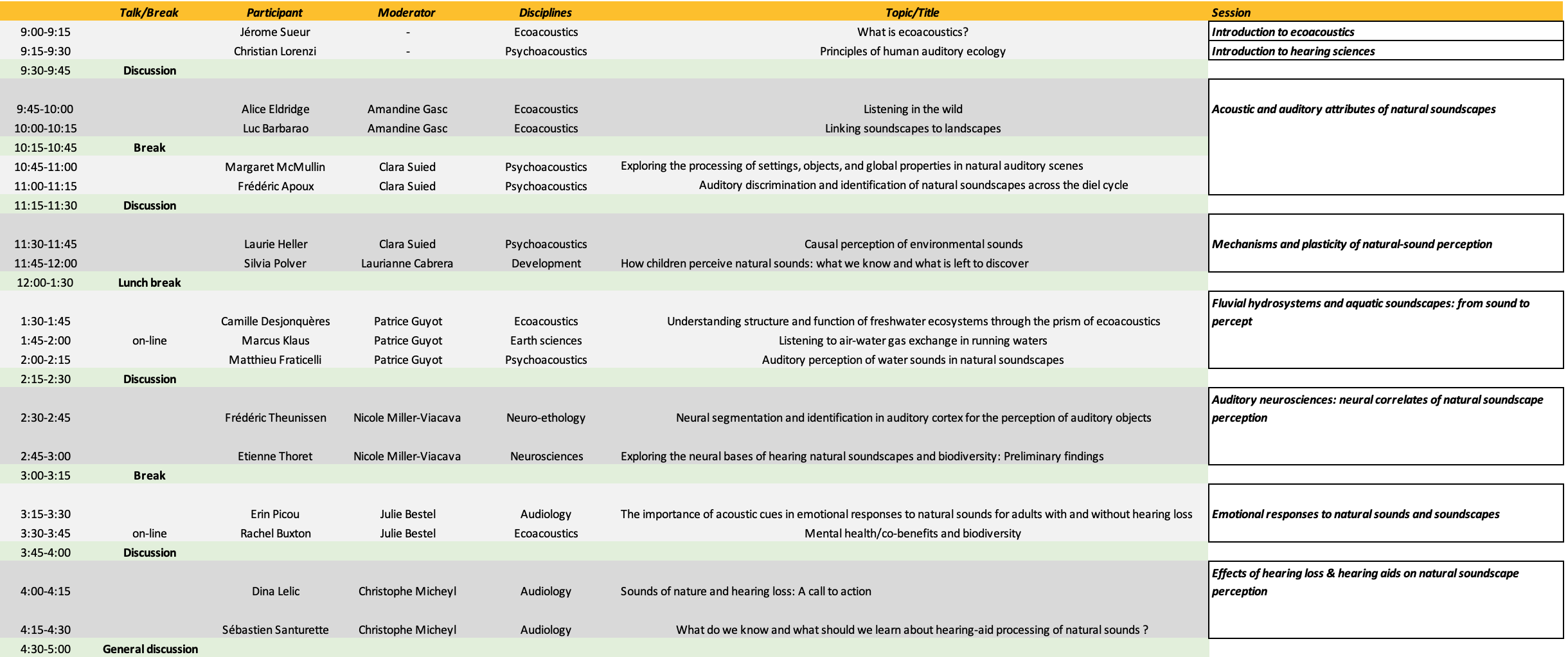
Tuesday 1 April, ENS, Salle Serre, 24 rue Lhomond, 75005 Paris (Download the program)


HAE 2024 – Laying the foundations of the field (I)
The first workshop was co-organized by ENS-PSL, MNHN in March 2024 on the exceptional site Biosphere 2 research station in Tucson Arizona, in close partnership with the IRL iGlobes CNRS, ENS-PSL, University of Arizona. Biosphere 2 (B2) was chosen as a symbolic venue as it is one of the world's most unique facilities dedicated to the research and understanding of global scientific issue, engaged in engages in world-class environmental research, education, and entrepreneurship leading to solutions for humanity’s grand challenges of climate change, biodiversity loss and sustainable development, on Earth and beyond.
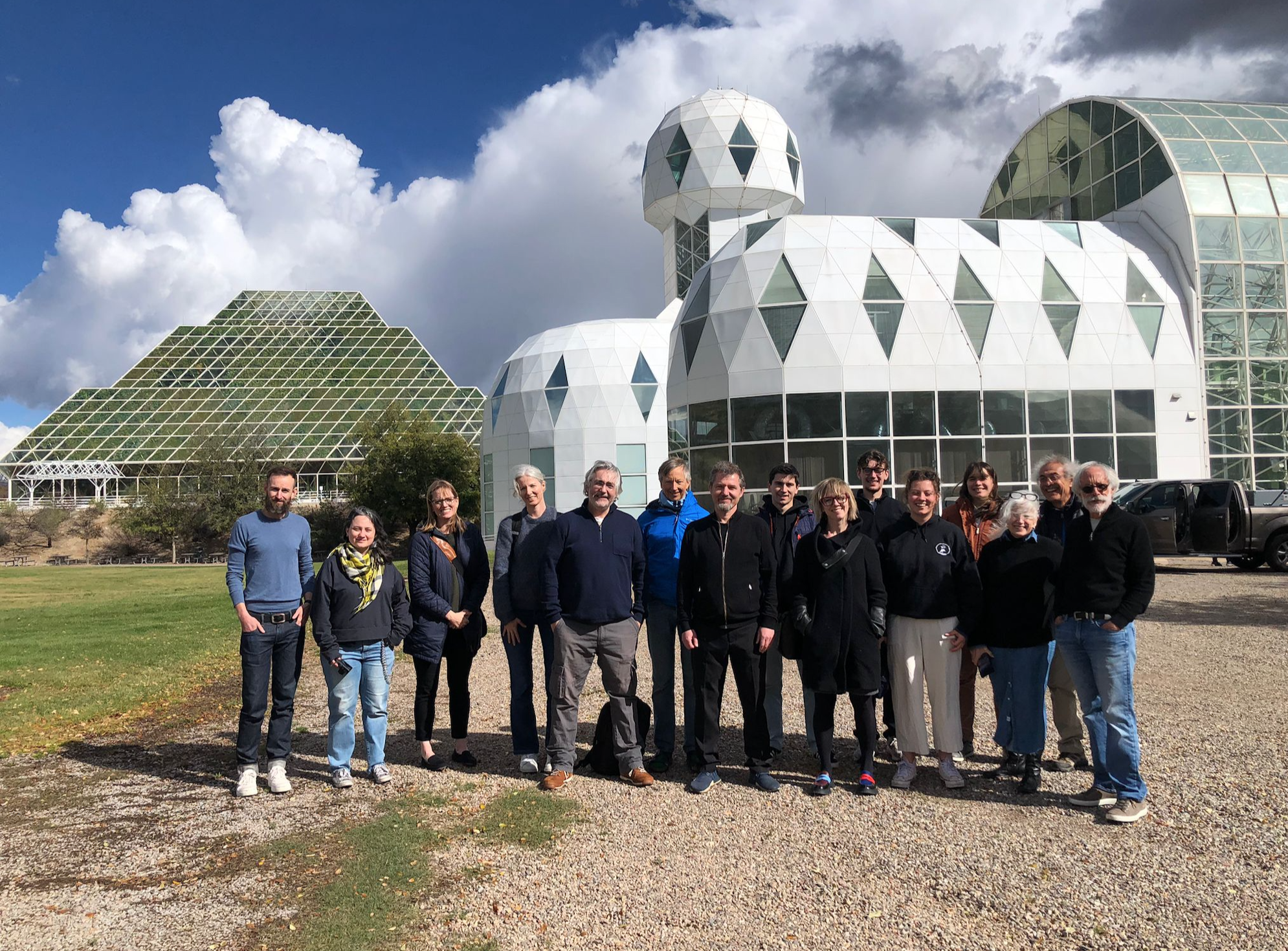
The workshop was opened by Régis Férrière (iGlobes), Jérôme Sueur (MNHN) and Christian Lorenzi (ENS-PSL).
Jérôme Sueur paid tribute to Bernie Krause, a pioneer in soundscape ecology, who accepted to sponsor and be part of this interdisciplinary event.
Human auditory ecology, a new field focusing on the study of human auditory perception of natural soundscapes
Natural soundscapes correspond to the complex arrangements of biological and geophysical sounds shaped by sound propagation through non-anthropogenic habitats. Human auditory ecology is a new field focusing on the study of human auditory perception of natural soundscapes, and more precisely human perception of ecological processes at work in natural habitats. Based on large acoustic databases with high ecological validity collected by ecologists using standardized procedures and material, human auditory ecology investigates the extent to which this presumably ancestral monitoring function of the human auditory system is adapted to specific information conveyed by natural soundscapes, whether it operates throughout the life span or whether it emerges through individual learning or cultural transmission. Beyond fundamental knowledge on human hearing, human auditory ecology should yield a better understanding of how normal-hearing and hearing-impaired listeners monitor rural and city green and blue spaces and benefit from them, and whether rehabilitation devices (hearing aids and cochlear implants) restore natural soundscape perception and emotional responses back to normal. Human auditory ecology should also reveal whether and how humans hear the rapid changes in the environment brought about by human activity.
The workshop was divided into six working sessions:
Session 1 - Statistics of natural soundscapes
This first session was opened by a keynote presentation of soundscape ecology and ecoacoustics by Rachel Buxton (soundscape ecology and ecoacoustics).
This was followed by presentations of material relevant to the topic carried out by three speakers : Fréderic Theunissen (neuro-ethology and signal processing); Josh McDermott (computational hearing sciences); Nicole Miller-Viacava (computational hearing sciences).
Discussions were chaired by Richard McWalter & Etienne Thoret. Amongs the different questions addressed in this session: Could soundscape ecologists help auditory scientists test efficient coding and auditory scene analysis principles? Natural sound databases: What matters : quality, metadata, quantity ?
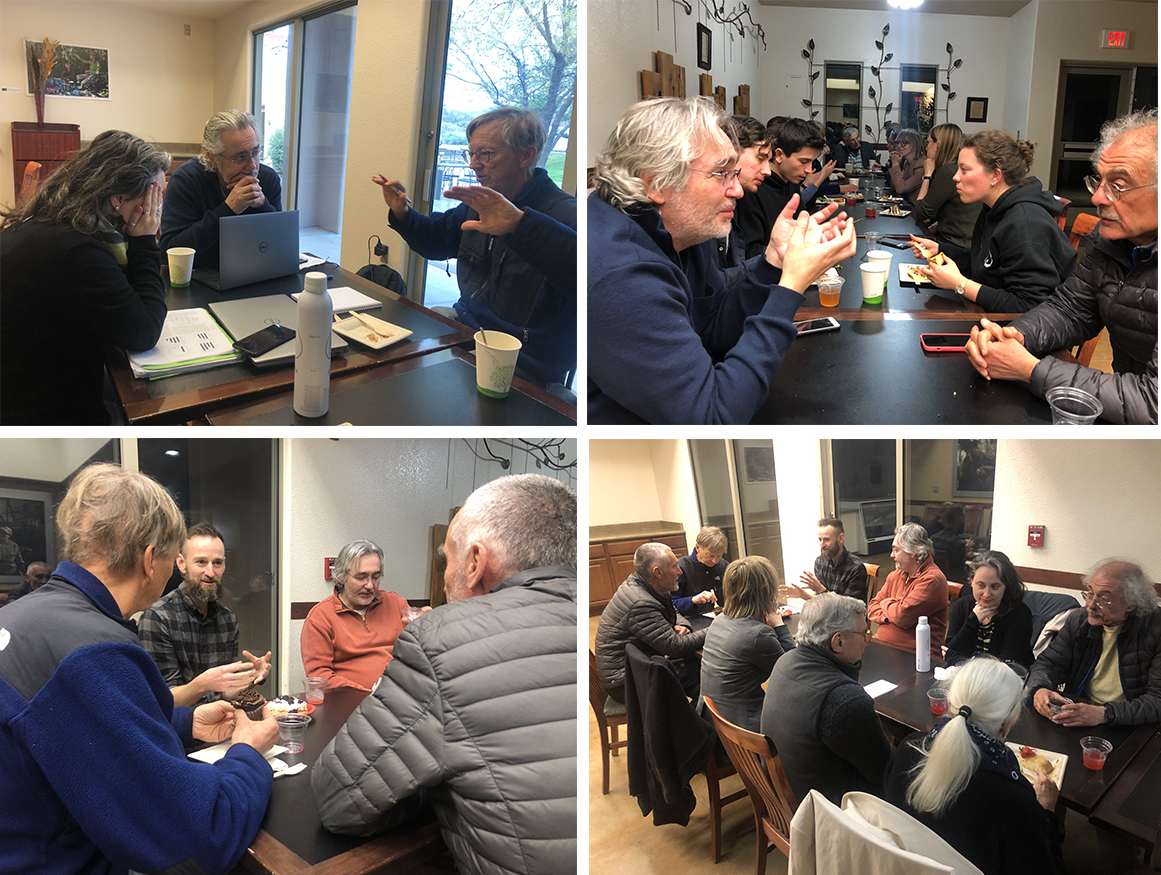
Session 2 - Monitoring auditory behaviors
This session was opened by a keynote presentation of environmental-sound perception by Valeriy Shafiro(psychoacoustics). This was followed by presentations carried out by three speakers : Timothy Mullet (soundscape ecology and ecoacoustics); Clara Suied (psychoacoustics); Nicolas Mathevon (bioacoustics). Discussions were chaired by Frédéric Apoux. Amongs the different questions addressed in this session: Are we equiped with an ancestral repertoire of ‘monitoring auditory behaviors’? Do we possess auditory mechanisms dedicated to the detection/discrimination of biophony and biodiversity, or detection of specific geophysical sounds?

Session 3 - Sensory vs emotional auditory processing
This session was opened by a keynote presentation of emotional processing of environmental sounds by Erin Picou(experimental audiology).
This was followed by presentations carried out by three speakers: Rachel Buxton (soundscape ecology and ecoacoustics); Dick Bottledooren (environmental acoustics, urban planning); Francesco Aletta (environmental acoutics, urban planning).
Discussions were chaired by Christian Lorenzi. Amongs the different questions addressed in this session: Are natural soundscapes ‘special’ for our emotional system? Could emotions modulate auditory processing of natural scenes?
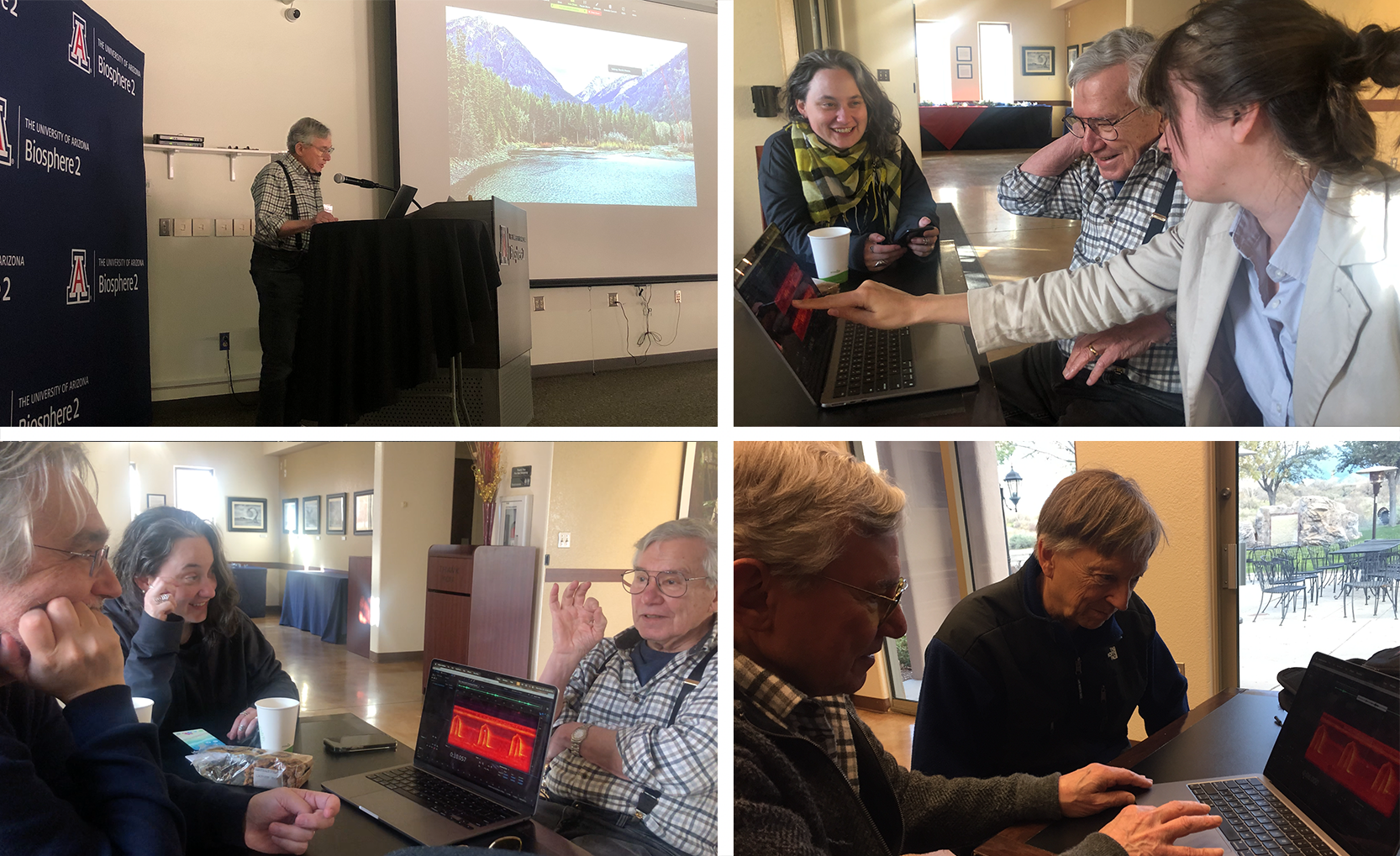
Session 4 - Developmental, learning and memory effects
This session was opened by a keynote presentation of developmental studies on environmental sounds by Judit Gervain (auditory development). This was followed by presentations carried out by two speakers Frédéric Theunissen (auditory neurosciences), Daniel Pressnitzer (psychoacoustics). Discussions were chaired by Shihab Shamma. Amongs the different questions addressed in this session: Do monitoring auditory functions operate throughout the life span or do they emerge through individual learning or cultural transmission? Are certain sounds (ie, water, birds) or habitats (ie, savannas) ‘special’ for our auditory brain?
Session 5 - Effects of hearing loss & hearing aids
This session was opened by a keynote presentation of audiological studies on environmental sounds by Valeriy Shafiro(psychoacoustics and audiology). This was followed by presentations carried out by two speakers : Dina Lelic(experimental and clinical audiology); Erin Picou (experimental and clinical audiology). Discussions were chaired by Nicole Miller-Viacava. Amongs the different questions addressed in this session: Do hearing-impaired people loose auditory contact with natural environments? Does it have any impact on them? Do hearing aids restore this contact?
Session 6 - Perception of environmental changes
This final session was opened by a keynote presentation of studies on awareness to environmental changes by Anne Sourdril (human geography).This was followed by presentations carried out by one speaker: Amandine Gasc(soundscape ecology and ecoacoustics). Discussions were chaired by Pauline Guinard (human geography). Amongst the questions addressed here: Do we perceive human-induced environmental changes such as those produced by invasive species, pollution, decline in biodiversity or climate change?
General discussion (all participants)
Chair: Christian Lorenzi (psychoacoustics, audiology, modelling).
Human auditory ecology’ – as discussed during this first workshop – was defined as a sub-field of auditory psychophysics and neurosciences. So, it is meant to encourage hearing scientists who traditionally work on speech and music perception in urban settings to collaborate with soundscape ecologists, ecoacousticians and neuro-ethologists, and share expertise with environmental acousticians and geographers (and maybe other fields such as anthropology, philosophy, etc.). It therefore aims at identifying testable working hypotheses guided by computational models of the human auditory system, to unveil low and high-level auditory mechanisms engaged in the auditory perception of soundscapes associated with natural habitats, how they develop through life and the extent to which they are affected by exposure, learning and culture. Although ‘Human auditory ecology’ aims at improving fundamental knowledge on the human auditory system and how humans interact with natural environments, it also aims at providing novel solutions to screen and rehabilitate hearing loss via hearing aids and cochlear implants.
Read more about Human Auditory Ecology
- Wikipedia page on Human Auditory Ecology : https://en.wikipedia.org/wiki/Human_auditory_ecology
- An innovative research program to shed light on potentially ancestral human auditory mechanisms (article published on the Ens-PSL website - in French)
- Loss of auditory contact with nature (published on the Département d'Etudes Cognitives of ENS website)
- Hearing loss: when the sounds of nature disappear (The Conversation - march 2024. In French)


